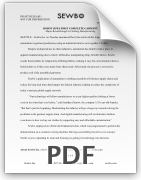T-Shirt Demonstration
Face Mask Sewing
Blue Jeans Sewing
Downloads
Background
Making clothes is a labor-intensive activity, and it’s been that way for thousands of years.1 Collecting fibers, making yarn, weaving fabric, and sewing clothes were time-consuming, tedious tasks.
The industrial revolution mechanized and automated textile production in the 18th century and the invention of the sewing machine in the 19th century moved the bottleneck to the cutting room. Computer controlled cutting machines solved this problem in the 20th century, leaving only the task of assembling clothing.2
But progress has stalled for the past 50 years, despite the hundreds of millions of dollars that have been spent in pursuit of automated garment production.3 Until now, robots have been incapable of assembling a complete garment.4
In 1970, experts predicted that we would have a man on Mars before apparel production is automated.5 Mars exploration is still on the horizon but, with Sewbo’s technology, automated clothing factories are just around the corner.
- Balter, Michael - Clothes Make the (Hu) Man Science Vol. 325, Issue 5946, pp. 1329
- Gerber, David - The Inventor's Dilemma: The Remarkable Life of H. Joseph Gerber 2015
- Drummond, Katie - Clothes Will Sew Themselves in Darpa’s Sweat-Free Sweatshops Wired - June 8, 2012
- Made to Measure The Economist - May 30, 2015
- Koshetz, Herbert - Apparel Makers Awaiting Automation New York Times - March 14, 1970
About Inventor

Jonathan Zornow, the inventor behind Sewbo, came up with the solution to automating garment manufacturing while reading about temporary support materials for 3D printers, which are water-soluble plastics that could be melted and molded. These materials let 3D printers build things that would otherwise be impossible, and he thought that the same concept could be applied to the garment industry.
This would ultimately prove to be a successful approach - but not before many long nights of tinkering, including a crowded stretch where he shared his tiny NYC studio apartment/workshop with a rented industrial robot.
Zornow studied economics and studio art at Brandeis University, where his sculpture thesis was a fresco-making machine called “Robotecelli.” Jon lives in San Francisco.
How it Works
Despite widespread use in other industries, automation has made little progress in clothing manufacturing due to the difficulties robots face when trying to manipulate limp, flexible fabrics.
Sewbo avoids these hurdles by temporarily stiffening fabrics, allowing off-the-shelf industrial robots to easily build garments from rigid cloth, just as if they were working with sheet metal. The fabric panels can be easily molded and welded before being permanently sewn together.
The water-soluble stiffener is removed at the end of the manufacturing process with a simple rinse in hot water, leaving a soft, fully assembled piece of clothing. The stiffener can then be recovered for reuse. The treatment uses a plastic called Polyvinyl Alcohol, a non-toxic polymer that is already used elsewhere in the textile production process, as a "sizing" that temporarily strengthens yarn during weaving.

 Press Release
Press Release  Jonathan Zornow
Jonathan Zornow Video Still #1
Video Still #1 Video Still #2
Video Still #2 Video Still #3
Video Still #3